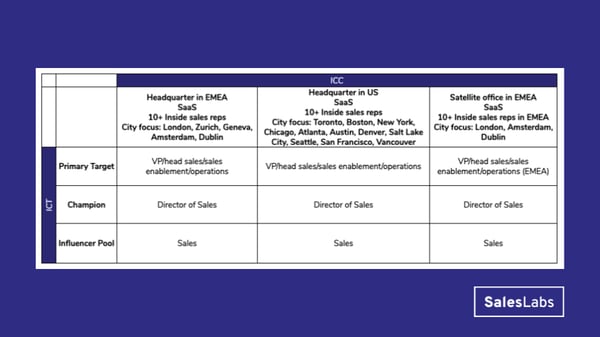July 22, 2020
 by Thibaut Souyris / July 22, 2020
by Thibaut Souyris / July 22, 2020

When building an SDR or sales/business development team, developing a playbook is of strategic importance.
An SDR playbook is a pivotal tool to guide your sales development efforts. In this guide, we’ll show you how to build a simple and effective SDR playbook.
It is quite common for SDR leaders to completely overlook the creation of a playbook. After all, sales development is evolving at an unprecedented pace, and documenting a process that will be outdated within months doesn’t make too much sense.
However, a central place where resources, tactics, and tools are compiled and updated is the minimum you can do to keep your SDRs aligned and working with the same goal in mind.
In this guide, you’ll discover the eight sections of your SDR playbook, how to build and update the content of your playbook, and how to distribute the playbook and make sure it is used to build a common language within your sales development organization.
The first step in building your SDR playbook is to define clear, quantifiable, and achievable goals.
Are you building the first version of your playbook or gathering resources, tools, and tactics from years of running an SDR team? Are you building it to generate a massive change in your organization or simply documenting unofficial organizational knowledge? These goals should be clear when building your playbook.
Here are some important steps to define your goals. We recommend using objectives and key results (OKRs).
There are so many cases where leaders start documenting their processes only to stop building the playbook at the first operational emergency. Planning and documenting processes is a long and arduous process, and it’s easy to keep focusing on other tasks that are more urgent, but have a lower impact on the long run. Here’s an example of an OKR related to the completion of an SDR playbook.
Objective: Finalize the V1 of the SDR Playbook
Key results:
Another critical aspect when building an SDR playbook is its distribution. It’s quite frequent to fully document processes, only to have everyone forgetting about them after a few weeks. It's wise to use a knowledge management solution to host your playbook and make sure it is widely distributed. Here’s an example of an OKR related to the distribution of your SDR playbook.
Objective: Distribute the playbook to the SDR team
Key results:
Finally, the adoption of the SDR playbook by the SDR team and every stakeholder involved with the team (sales analysts, AEs, managers…) is critical to the success of your playbook. It’s an ongoing process, but an official launch and regular training sessions are good ways to get started. Here’s an example of an OKR related to the adoption of your SDR playbook.
Objective: Ensure the adoption of the SDR playbook by the SDR team
Key results: Now that your goals are clear, it’s time to build the sections of your SDR playbook.
The content of your SDR playbook is divided into sections that will help every user find relevant information fast. It is also a good way to build and document a common language, so make sure your sections reflect your team’s vocabulary.
Of all the mistakes SDRs make, not having clear Ideal Customer Profiles is the most common. Your playbook should have an extensive section about your customers and prospects, what problems they face, and how your solution is solving parts or all of the problems.
Make sure you build your ICP using an ICP Matrix, which includes your Ideal Customer Company (ICC), and your Ideal Customer Title (ICT). It should look like this:

Once you have a clear understanding of your ICPs, it’s important to list the problems they are trying to solve. Every ICT has different types of problems.
Typically, a decision-maker will worry about market shares, risks, opportunities, and how their company can make more money or save money. A champion will worry about getting a promotion, keeping her job, or spending less time doing repetitive tasks. According to Skip Miller, 70-80% of buyers make decisions to avoid pain, whereas 100% of sales literature is focused on features and benefits.
Where are your leads coming from? Do you have a team of sales analysts preparing leads for your SDRs? Do you use demand generation software?
These are typical questions you need to answer in your Lead Sourcing section. Some sales teams have role specialization, meaning that they divide the work between different departments. Some SDRs will receive leads inbound, but they have to manually look for outbound leads, using the ICP matrix.
Below are some common sources for leads:
Once your lead sources are clear, you need to define what a marketing qualified lead (MQL) and a sales qualified lead (SQL) mean to you.
An MQL is a lead who has engaged with your company and could become a customer if nurtured correctly. Typically, it’s a lead that has downloaded an ebook, signed up for a webinar, or started a chat on a live chat software. An SQL is a prospective customer that is ready to talk to a sales team. Leads who requested a demo are SQLs.
Modern sales development teams use various prospecting channels. A few years ago, options were very limited and sales reps had to use cold calling or cold emailing as their main prospecting channels. Nowadays, an SDR can use a vast arsenal of tools to get in touch with prospects.
Therefore, it’s important to list what channels are used in your organization. This will allow your reps to understand how prospects are typically contacted.
Here is a list of typical outbound prospecting channels:
Each of these channels can be used in various ways. On LinkedIn for example, you can send a text-based message, share a voicemail, send a sponsored InMail or share a video. The options SDRs have right now are really varied and powerful in comparison to the tools reps had at the beginning of the century.
Another important aspect to include in your prospecting channel section is the performance of each channel. This will allow new reps to understand their performance compared to their peers and have goals to aim for.
This section is critical to help your reps understand what they are selling. This will allow them to pick resources, based on the situation they are facing. Below are important subsections to include:
In this section, you can include your service/product information, some features/benefit lists, and slide decks. I would also recommend listing your customers by industry, so your SDRs can use relevant references to build credibility in their outreach.
Case studies are extremely important to help your SDRs concretely understand how your solution helps your customers. Make sure to compile them by industry. This will help them be relevant when sharing examples to prospects.
Largely overlooked, glossaries are key to building a common language and getting new SDRs up to speed. Overall, the offering and use cases knowledge section helps standardize the knowledge of your solution. I would avoid putting too much emphasis on the history of your company, leadership and accolades, as prospects typically do not care about that.
This is where you will compile your templates, sequences, USPs, links and outreach collateral. This section should be quite extensive as it is the reflection of your sales development team’s communication with your prospects.
As your reps build their expertise, they will start producing powerful templates that can be shared throughout the organization. I recommend compiling them in this section. This will seriously accelerate the onboarding of your new reps as they can get inspired by efficient templates.
On a word of caution, however. Make sure your reps build messages in their own style. If every member of your team uses the same templates, prospects will smell it and will not answer to your prospecting efforts. Templates are very useful to pick some snippets and powerful USPs, but every SDR should be creative and relevant in their outreach.
Sequences are also very useful to document. You will be able to share the types of touchpoints, the cadence and the open rate, reply rate, and booking rates. Make sure your reps build their own sequences too. Again, creativity and relevance are key in cold outreach.
The collateral section is where you will store your prospecting marketing material. Include links to specific landing pages, webinar signup pages, one-pagers, and any type of relevant outreach content. It’s important to keep this section updated as links can quickly become outdated and lose relevance.
This is where you store industry material. It will allow your reps to gather data on your prospect’s problems and how they can potentially solve them. If you’re selling an expense management software, a good example would be a blog post on how to collect receipts from various airlines or train companies. With this kind of blog post, your team can reach out to a prospect and show immediate value by solving a problem they regularly face.
Content creation and curation is critical in modern prospecting. If your customers are on LinkedIn or any other professional social network, your team can leverage that to attract new prospects.
However, you need to share guidelines and best practices to help your reps create posts, videos, and make sure they stay on brand. Include examples of content that can be shared, tutorials on how to shoot a video or how to get started with social selling.
Tools are essential components of modern prospecting. In just a few years, the sales enablement category has exploded. Building a solid sales stack plays a huge role in your sales development team’s success.
In the tools section, document every tool you use to make your SDRs life easier. You’ll typically find tools for lead sourcing, CRM, email automation, communication, knowledge sharing, internal communication and many more.
Include tutorials and training recordings to help your team adopt the tools. Very often, sales leaders heavily invest in sales enablement tools, only to have reps giving up because of the complexity of a tool. I’d also recommend running regular refresher sessions.
A section to document the targets of the team and the metrics will tie your playbook together. In this section, you can share your monthly/quarterly targets and store regular team updates, including the past performance and forecasts.
Make sure to clearly indicate which metrics are tracked in this section. You should also have a simple way of measuring the real-time performance of the team, using sales gamification software.
Finally, a section where your team can get updates on the SDR organization will help with the adoption of your playbook. You can host the slides of your team meetings, document important announcements, and surface topical sections of the playbook (leaderboard for a specific competition, SPIF, new hire spotlight, etc).
Once the structure of your playbook is clear, it’s time to build to the content of the playbook and make sure it stays up to date. Here’s how to do that.
This is the longest and most challenging part of the exercise. That’s why you should have a clear outline and the eight sections mentioned above. Gather all the relevant information and documents, section by section. Once done, organize the content in subsections, and build your content in these sections.
It’s recommended that you use knowledge management software to host your playbook. You can also use a simple cloud content collaboration software, but this tends to scale poorly and reduce the adoption of your playbook.
Keep in mind that building the initial content of your SDR playbook can be a daunting task. Don’t hesitate to set specific OKRs and assign responsibilities to team members.
Your SDR playbook is a living document. As your sales development team keeps discovering new ways to generate opportunities, it is important to document new tactics, updated marketing materials and more granular versions of your ICP matrix.
All too often, once the first version of the playbook is done, the team stops updating it, turning it into an archive. To update the content of your playbook, make sure to run monthly or quarterly update sessions. You can gather your team to surface new ideas, improvement suggestions, and plan an update project.
Another approach is continuous improvement. A lot of knowledge management solutions allow team members to vote for improvements, leave suggestions, and update the playbook. Make sure someone is accountable for the playbook’s hygiene.
Finally, your SDR playbook has to be widely distributed and adopted to be useful. This is where tools can be really helpful in building healthy habits for your reps.
During the onboarding process, make sure to cover the SDR playbook in detail and have new reps understand that they can find most of the SDR team’s knowledge in the playbook. Use the playbook as your reference guide, share links in your internal communication and make sure your reps keep using it to gain knowledge.
Another good way to distribute the playbook is to use it to host any team’s wide or company wide communication. Most knowledge management solutions will allow you to send email or desktop notifications and have reps click on the notification to access the content on the platform hosting the playbook.
Finally, integrate your playbook with your business instant messaging software. Most teams heavily rely on these communication channels to function, which is a great opportunity to organically boost the distribution of your playbook. Some softwares allow you to directly recover content of the playbook, with a layer of artificial intelligence.
Remember that your SDR playbook will constantly evolve. Have members of your team give suggestions, invite other teams (marketing, product, etc) to document sections where their input is needed. This will keep your playbook alive, document important organizational knowledge, and help support the prospecting efforts of your sales development team.
Thibaut Souyris is the CEO and Founder of SalesLabs. He trains and coaches B2B sales teams to start more conversations and close deals faster. He is the creator of the T-shaped SDR, and he is regularly invited to share his expertise on various sales blogs and at events.
There’s no doubt that technology has changed the way sales professionals operate.
 by Ben Goldberg
by Ben Goldberg
You might be thinking that a sales development representative is just a typical sales job,...
 by Sarah Drake
by Sarah Drake
A lot of factors contribute to whether or not a sales rep hits their quota.
 by Mary Clare Novak
by Mary Clare Novak
There’s no doubt that technology has changed the way sales professionals operate.
 by Ben Goldberg
by Ben Goldberg
You might be thinking that a sales development representative is just a typical sales job,...
 by Sarah Drake
by Sarah Drake


